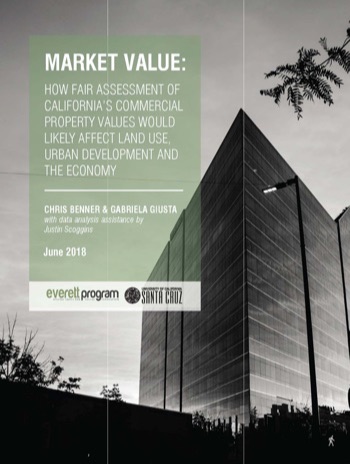Campus News
Reforming California’s commercial property tax system would boost the economy, report says
Reforming California’s property tax structure to tax commercial properties at their market value would boost the economy by generating new revenue, stimulating development, and diversifying industry, according to a new report by researchers at the University of California, Santa Cruz.


Reforming California’s property tax structure to tax commercial properties at their market value would boost the economy by generating new revenue, stimulating development, and diversifying industry, according to a new report by researchers at the University of California, Santa Cruz.
The report, “Market Value: How Fair Assessment of California’s Commercial Property Values Would Likely Affect Land Use, Urban Development and the Economy,” was issued today (June 19) by the Everett Program for Technology and Social Change at UC Santa Cruz.
“As we mark the 40th anniversary of Proposition 13, it’s time to look at the legacy it has created in California,” said lead author Chris Benner, executive director of the Everett Program and a professor of sociology and environmental studies. “Our analysis identified broad economic benefits of assessing commercial and industrial properties at fair market value—without changing the system for residential properties.”
Benner coauthored the report with Gabriela Giusta, research associate for the Everett Program; Justin Scoggins, data manager at the Program for Environmental and Regional Equity at the University of Southern California, provided assistance with data analysis.
Half of all commercial properties are currently assessed at fair or near fair market value; reforming the system would bring the others up to today’s values, said Benner. “Taxing commercial properties at market rates would level the playing field for all land owners and provide a more equitable tax structure for all businesses,” he said. “The current system subsidizes older businesses that own their property, creating a competitive disadvantage for businesses that lease or have purchased their property more recently.”
Reform would generate an estimated $11.4 billion in new revenue, according to an analysis by contributor Manuel Pastor, professor of sociology and American studies and ethnicity at USC. That figure represents less than .5 percent of the overall state economy, so the overall impact on the economy and jobs is likely to be small, Benner predicted. Additional revenue for local governments would go to education and public services, however, sparking likely increases in spending on infrastructure, as well, said Benner. Ripple effects of reform would likely include cities shifting away from strategies they have adopted to make up for lost revenue, including sales taxes, lodging taxes, utility taxes, and development fees, according to the report.
Paying taxes based on fair market value would also provide an incentive for companies to find ways to generate more revenue from the use of their land, including the development of vacant land and making better use of underutilized land, he said. Underassessment of commercial property values has a “clear and large drag on the development of vacant lots,” the report found.
“Our statewide analysis found that vacant properties that were valued closer to market value were five times more likely to be developed than properties whose tax base year was in the 1970s and early 1980s,” said Benner.
Small businesses that have owned their property for a long time would have the most difficulty adjusting to being taxed at market-rate property values, said Benner, who holds the Dorothy E. Everett Chair for Global Innovation and Social Entrepreneurship.
Cities’ under-reliance on property tax revenues likely distorts land markets in ways that undermine investment in infrastructure and encourage growth in retail and hospitality industries, which typically have quite low wages, said Benner, an economist who has authored or coauthored six books on employment, economic growth, and social equity. “Reforming commercial property taxes would likely bring in more diverse industries and stimulate economic growth,” he said.
The report’s conclusions are a significant contribution to the public conversation about the impacts of reforming California’s commercial property tax system—an understudied topic, said Benner. Previous studies have yielded somewhat mixed results, with some predicting slight negative impacts on macro-economic growth and others finding no impact, or a slight positive effect. One prominent 2012 study by the Davenport Institute at Pepperdine University’s School of Public Policy estimated that reforms would generate roughly $6 billion annually but also cost nearly 400,000 jobs and $72 billion in lost output. Benner said that study’s revenue estimate was reasonable but the estimates of total costs were based on an analysis that was technically flawed and thus highly misleading.
“Those findings echo many public concerns about job losses associated with tax increases, which is why it was worthwhile to review the findings in depth,” said Benner. “Overall, we found that reforming the commercial property tax structure would likely have a modest positive impact on the structure and dynamics of California’s economy.”